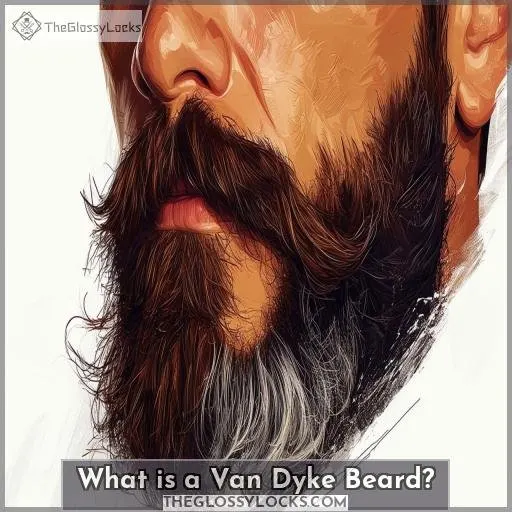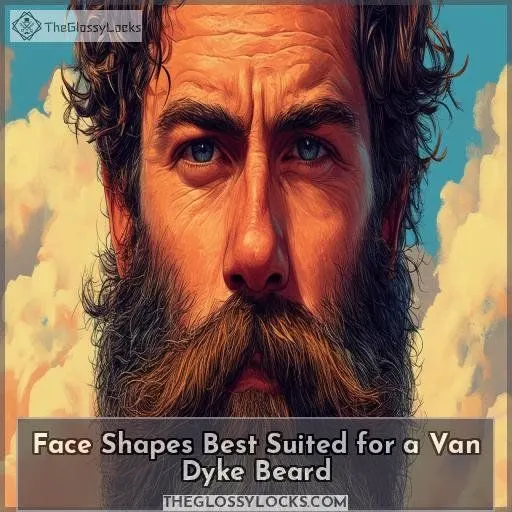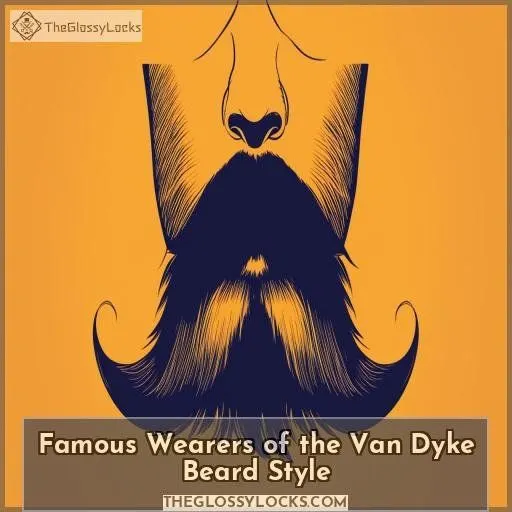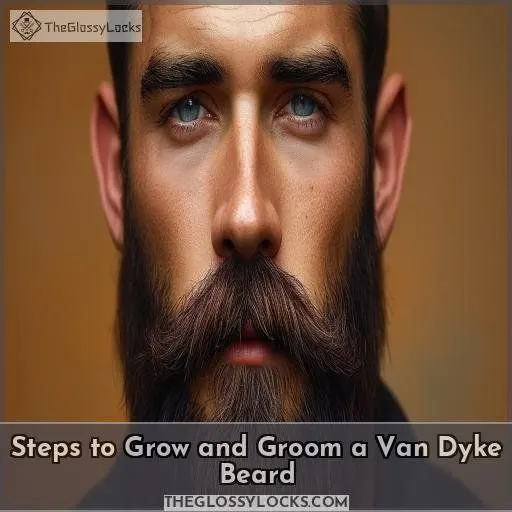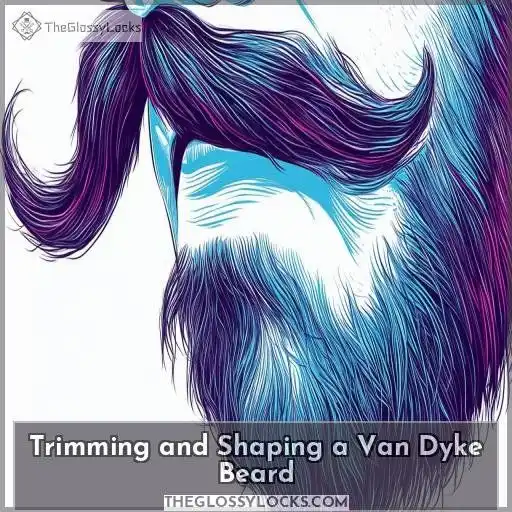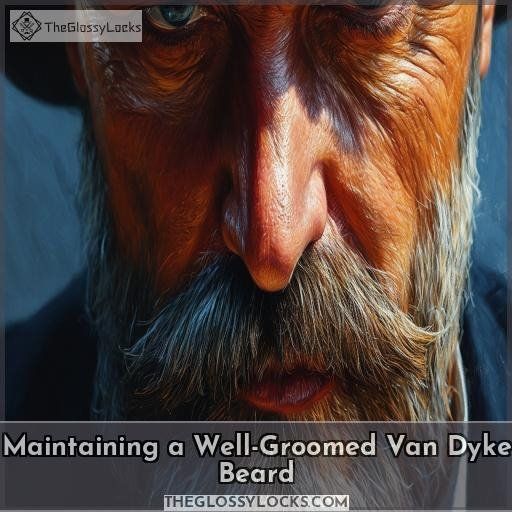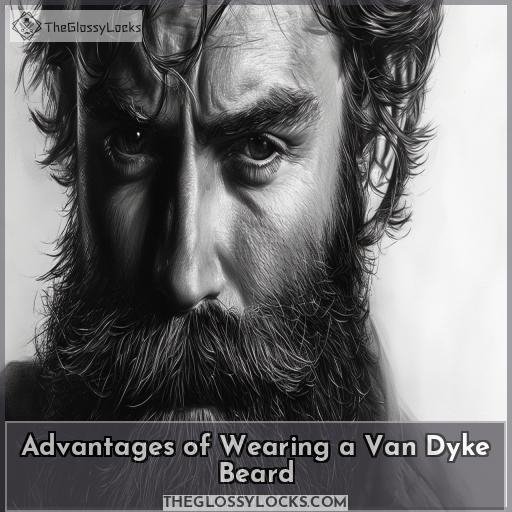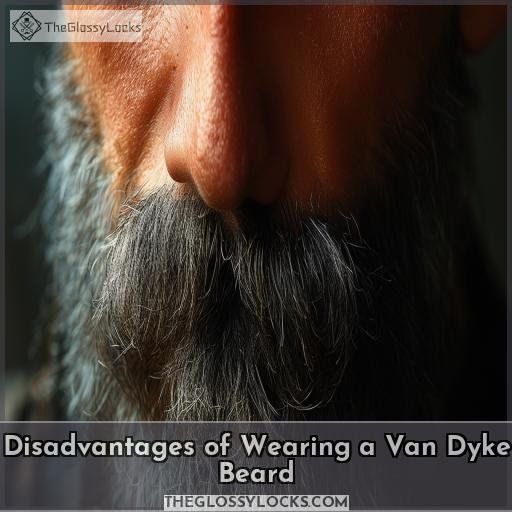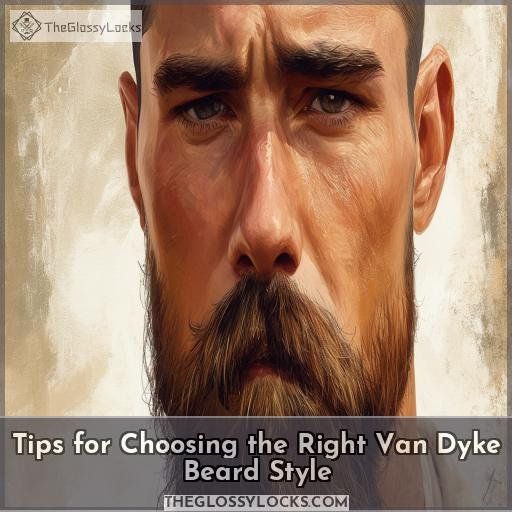This site is supported by our readers. We may earn a commission, at no cost to you, if you purchase through links.
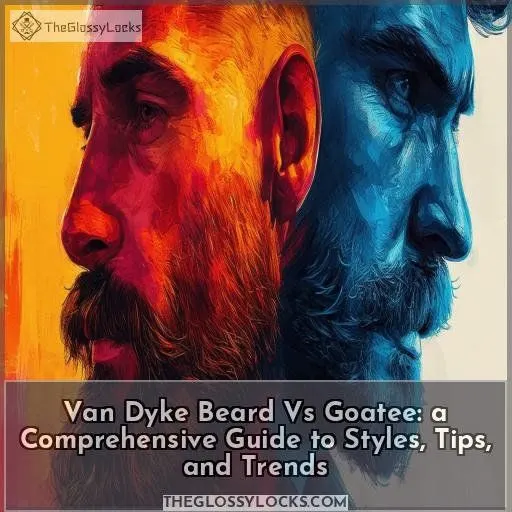 A Van Dyke beard and a goatee are both popular facial hair styles, but they have distinct characteristics. The Van Dyke beard, named after Sir Anthony Van Dyck, features a pointed chin beard and a mustache, with a clean-shaven gap in between, offering versatility with various combinations .
A Van Dyke beard and a goatee are both popular facial hair styles, but they have distinct characteristics. The Van Dyke beard, named after Sir Anthony Van Dyck, features a pointed chin beard and a mustache, with a clean-shaven gap in between, offering versatility with various combinations .
In contrast, a goatee typically consists of a small beard on the chin without a mustache, though some variations might include one .
The Van Dyke suits a range of face shapes and often requires regular trimming to maintain its distinct separation, enhancing personal grooming and aesthetics .
Want to refine your style? There’s more to discover.
Table Of Contents
- Key Takeaways
- What is a Van Dyke Beard?
- Face Shapes Best Suited for a Van Dyke Beard
- Famous Wearers of the Van Dyke Beard Style
- Steps to Grow and Groom a Van Dyke Beard
- Trimming and Shaping a Van Dyke Beard
- Maintaining a Well-Groomed Van Dyke Beard
- Advantages of Wearing a Van Dyke Beard
- Disadvantages of Wearing a Van Dyke Beard
- Tips for Choosing the Right Van Dyke Beard Style
- Frequently Asked Questions (FAQs)
- Is a Van Dyke a goatee?
- Do I look better with a beard or goatee?
- Is the Van Dyke beard attractive?
- How far under the chin should goatee go?
- How does a Van Dyke compare to other goatee styles?
- What historical significance does the Van Dyke beard hold?
- Are there specific hair textures suited for a Van Dyke?
- Can a Van Dyke beard be dyed effectively?
- How do cultural views influence the Van Dyke beards popularity?
- Conclusion
Key Takeaways
- Van Dyke and goatee are both facial hair styles, but a Van Dyke includes a mustache and a pointed chin beard, while a goatee is just a beard on the chin.
- The Van Dyke is a versatile style that can suit a variety of face shapes, while a goatee is best suited for square, oval, and round faces.
- Both styles require regular maintenance, but a Van Dyke requires more frequent trimming to maintain its shape.
- The Van Dyke has been a popular style for centuries, and it continues to be worn by celebrities and everyday guys alike.
What is a Van Dyke Beard?
The Van Dyke beard, named after Flemish painter Sir Anthony Van Dyck, features a chin puff combined with a mustache, often a handlebar style, with clean-shaven cheeks. This style includes variations such as different beard lengths, extravagant mustache styles, and sometimes an anchor-like shape.
Definition of a Van Dyke Beard
A Van Dyke beard, originating from the 17th-century painter Sir Anthony Van Dyck, is a facial hair style combining a classic goatee with a mustache. This style features a clean-shaven gap between the beard and the mustache, allowing for various mustache and goatee combinations, offering versatility in personal grooming and aesthetics .
Characteristics of a Van Dyke Beard
The Van Dyke beard stands out for its distinct combination of a pointed chin beard and a mustache, often a handlebar style, with a clean-shaven separation between them (Source). This style is frequently seen on historical figures like King Charles I and modern celebrities such as Johnny Depp .
Variations of the Van Dyke Beard Style
The Van Dyke beard has various styles, including the full Van Dyke, short Van Dyke, thick Van Dyke, and modern Van Dyke. Each variation features a distinct combination of a goatee and mustache, often emphasizing different lengths and thicknesses. Selecting the right style can enhance your face shape and add a sophisticated touch to your look.
Face Shapes Best Suited for a Van Dyke Beard
When selecting a Van Dyke beard style, consider how it complements your face shape. It’s particularly well-suited for square, oval, round, and heart-shaped faces, enhancing distinctive features while offering a stylish look .
Square Face Shape
A Van Dyke beard with its origins rooted in elegance complements square faces. With sharp lines highlighting your jawline, maintain the beard fuller at the chin. Regular Van Dyke grooming tips, including trimming and shaping, guarantee a polished appearance, enhancing facial features.
Oval Face Shape
For an oval, you’ve got the freedom to experiment with various beard options. Suitable beard styles enhance your natural symmetry.
- The classic Van Dyke
- The striking anchor beard, often worn by Christian Bale
- Johnny Depp’s iconic style
- Mel Gibson’s rugged look
Round Face Shape
When you have a round face, the Van Dyke beard can be an excellent choice. It elongates the face, creating angles that flatter. Here’s a quick comparison of styles:
| Style | Cheeks | Chin Area | Mustache | Overall Look | Maintenance |
|---|---|---|---|---|---|
| Goatee | Shaven | Full | Optional | Defined Chin | Moderate |
| Circle Beard | Clean | Connected to Mustache | Yes | Balanced | High |
| Van Dyke Beard | Clean | Chin Puff | Handlebar | Stylish Angles | Regular |
| Chin Puff | Shaven | Extended Fullness | None | Elongated Face | Low |
| Disconnected Goatee | Clean | Full | Optional | Stylish Contrast | Regular |
Heart-shaped Face
For a heart-shaped face, a Van Dyke beard can balance your wider forehead and narrower chin beautifully. This beard style with a distinctive mustache and neatly trimmed goatee highlights your cheekbones, creating memorable faces. Follow beard maintenance and styling tips for best results .
Famous Wearers of the Van Dyke Beard Style
In acknowledging the enduring allure of the Van Dyke beard, it’s pertinent to mention iconic figures like Sir Anthony Van Dyck, for whom the style is named, and King Charles I of England. Contemporary personalities such as Johnny Depp and Mel Gibson also showcase this distinguished look, reflecting its steadfast popularity and versatility across different eras .
Sir Anthony Van Dyck (namesake)
Sir Anthony Van Dyck popularized the Van Dyke beard style, blending artistic significance with cultural impact. His iconic portraits often featured this distinct facial hair, influencing fashion trends in his era and beyond, seen today in celebrities like Brad Pitt and David Beckham.
King Charles I of England
King Charles I of England famously sported a Van Dyke beard, blending fashion and royalty. His distinguished look, combining a scruffy goat-style beard with regal grooming, marked a significant moment in monarchy history, influencing grooming trends and beatniks alike (Source).
Johnny Depp
Johnny Depp’s style showcases a modern variation of the Van Dyke beard, making it iconic in pop culture. Celebrities who wear it draw inspiration from Depp’s distinct look, blending classic and contemporary elements. His Van Dyke beard highlights personal expression and fashion-forward thinking.
Mel Gibson
Mel Gibson’s beard evolution showcases how his iconic Van Dyke beard influenced Hollywood trends. Gibson’s influence extended from film to fashion, making beard accessories popular. His signature style, blending rugged charm with precise grooming, elevated the Van Dyke as a classic Hollywood staple.
Steps to Grow and Groom a Van Dyke Beard
To grow and groom a Van Dyke beard, start by allowing your beard and mustache to grow out to a moderate length while keeping your cheeks clean-shaven. Regularly trim and shape the beard and mustache, focusing on maintaining the distinctive gap between them for a polished look.
Growing Out the Beard and Mustache
To grow out a Van Dyke beard, focus on letting the beard and mustache grow to a desired length, ensuring even growth. Regularly trim your neckline to keep it clean and tidy. Shape the mustache to complement your beard, and experiment with different styling variations to find the one that best suits your style.
Trimming and Shaping the Beard
To trim and shape your Van Dyke beard, follow these steps:
- Use trimmers to define and carve the edges.
- Employ scissors for precise shaping.
- Tidy up cheeks and neck to remove stray hairs.
- Shape the beard and mustache for symmetry.
Incorporate these essential tools for thorough beard care and grooming routine.
Maintaining the Desired Length and Shape
To maintain your Van Dyke Beard’s length and shape, regularly trim using quality grooming tools. Focus on maintaining defined cheek and necklines. Use scissors for precision when handling stray hairs, and consider a good trimming guide. Apply beard oils and balms to keep the hair soft and manageable, ensuring a stylish appearance.
Trimming and Shaping a Van Dyke Beard
To expertly trim and shape a Van Dyke, start by using trimmers and scissors to achieve the desired length and remove unwanted hair on cheeks and neck. Make sure you carefully shape the beard and mustache, maintaining clean lines and a distinct separation between the two .
Using Trimmers and Scissors
When shaping your Van Dyke beard, start with using trimmers for precision. Trim the mustache and goatee using a trimmer with the appropriate guard length, then switch to scissors for refining. Using scissors, carefully trim stray hairs and shape the goatee, ensuring symmetry for a polished look. Maintain control for a sharp, defined style.
Removing Unwanted Hair on Cheeks and Neck
To remove unwanted hair on your cheeks and neck, start with an electric trimmer. Select a guard to leave some stubble, if preferred. Shave upwards on the cheeks to define cheekbones and use a smaller guard for the neck area. Guarantee a clean, professional look, maintaining crisp lines and avoiding irritation .
Shaping the Beard and Mustache
Next, focus on shaping your Van Dyke beard and mustache. Use precise trimming techniques to achieve sharp edges and clean lines. Experiment with various style variations to find what suits your face shape best. Regular grooming routines and quality beard care products help your beard stay sharp and stylish, highlighting your features perfectly.
Maintaining a Well-Groomed Van Dyke Beard
To maintain a well-groomed Van Dyke beard, guarantee regular trimming and shaping using quality beard tools for precise control. Additionally, applying beard oils and balms will keep the beard healthy and the skin underneath moisturized and free from irritation.
Regular Trimming and Shaping
To keep your Van Dyke beard looking sharp, regular trimming and shaping are mandatory. Follow these steps to maintain a well-groomed appearance:
- Trim stray hairs using an electric trimmer.
- Define the edges of your beard and mustache.
- Shave the cheeks and neck clean.
- Periodically shape your mustache for a polished look.
Use these beard maintenance tips and styling techniques to achieve trendy variations and modern interpretations of the Van Dyke beard style.
Using Beard Oils and Balms
Using beard oils and balms is pivotal for maintaining a well-groomed Van Dyke beard. Beard oils moisturize and soften the hair, making it easier to shape, while beard balms provide hold and definition. Consistent use enhances appearance and ensures your beard remains healthy, both essential aspects of effective beard grooming and maintenance .
Keeping the Skin Underneath Healthy
Maintain healthy skin under your Van Dyke beard by using a moisturizing regimen, including beard oil benefits. Apply hydration products daily to keep skin supple. Exfoliating treatments aid in skin renewal, reducing buildup that can cause irritation. Consistent care prevents dryness and itching, promoting overall skin health and a well-groomed appearance.
Advantages of Wearing a Van Dyke Beard
Wearing a Van Dyke beard enhances your facial features by adding a distinguished contrast between the beard, mustache, and clean-shaven cheeks. It allows you to express personal style while potentially attracting attention due to its classic and refined appearance .
Enhancing Facial Features
Wearing a Van Dyke beard expertly highlights your facial features. The distinct separation between the mustache and chin beard enhances facial structure, creating a balanced look. It suits various face shapes, from oval to square, and adds a refined touch. Keep up with grooming habits and beard care to maintain sharp lines and impeccable style.
Expressing Personal Style
Expressing personal style with a Van Dyke beard allows you to align with modern trends and stand out like Johnny Depp or Mel Gibson. It’s ideal for beginners seeking a classic yet contemporary look. Experiment with different shapes, lengths, and a soul patch to reflect your unique personality while staying fashionable .
Potential to Attract Attention
Wearing a Van Dyke beard can attract attention and elevate your style. Here’s why:
- Popularity by Era: This iconic style thrived in various eras, giving it historic context.
- Celebrities with Style: Popularized by stars like Johnny Depp, it resonates in fashion trends.
- Professional Settings: It’s adaptable, lending a sophisticated edge to one’s appearance.
Disadvantages of Wearing a Van Dyke Beard
Wearing a Van Dyke beard demands consistent upkeep and precise grooming to maintain its distinct shape. It may also not complement every face shape and can occasionally be viewed as unprofessional in certain environments .
Requires Regular Maintenance
Maintaining a Van Dyke beard demands commitment. You’ll need tools like trimmers and scissors and guarantee regular trims to keep it sharp. Invest in quality facial products to maintain both beard and skin health. Professional advice can be invaluable for perfect shaping and maintenance.
| Tools | Maintenance |
|---|---|
| Trimmers | Regular Trimming |
| Scissors | Shaping the Beard |
| Facial Products | Maintaining Skin Health |
May Not Suit All Face Shapes
When examining the Van Dyke beard, it’s essential to acknowledge that it may not suit all face shapes. Here are key points to note:
- Oblong Faces: The Van Dyke can elongate your face even more.
- Round Faces: It may not create enough angles.
- Heart-Shaped Faces: Potentially emphasizes a narrow chin.
- Square Faces: Can accentuate a strong jawline effectively.
Can Be Perceived as Unprofessional in Some Settings
Maintaining a Van Dyke beard involves regular upkeep, which some might find demanding. Additionally, in professional settings, it may be seen as too unconventional, impacting your image. The concern is heightened for upscale occasions where personal style is judged more critically.
| Aspect | Professional Setting | Upscale Occasions | Social Media Presence |
|---|---|---|---|
| Maintenance | High | High | Medium |
| Perception | Unconventional | Critical | Mixed |
| Suitability | Varies | Questionable | Creative |
Tips for Choosing the Right Van Dyke Beard Style
Choose the right Van Dyke beard style by considering your face shape and features, experimenting with different lengths and shapes, and seeking advice from a professional barber or stylist. Matching your beard style with your natural contours and consulting experts can help you achieve the best look .
Consider Your Face Shape and Features
Choosing the right Van Dyke beard style involves considering your face shape and features. Here’s a quick guide:
- Square Face: Highlight strong angles by keeping the beard pointed.
- Oval Face: Almost any Van Dyke variation works.
- Round Face: Add definition and angles, avoid excessive width.
- Heart-shaped Face: Complement the narrow chin with precise trimming.
Experiment With Different Lengths and Shapes
To master the Van Dyke beard, experiment with different lengths and shapes. Shorter styles accentuate sharp features, while longer versions exude rugged sophistication.
Maintain your preferred style and stay abreast of facial hair trends with consistent grooming techniques. Adapting your beard care routine to the evolving trends will help you achieve a polished and fashionable look.
Experiment to discover your unique style.
Seek Advice From a Professional Barber or Stylist
To refine your Van Dyke beard style, consult a professional barber. They guarantee facial harmony and offer guidance on maintenance tools and styling choices. A polished look aligns with fashion trends and improves your overall appearance.
- Discuss face shape and features
- Explore various lengths
- Consider lifestyle
- Utilize quality tools
- Regularly maintain
Frequently Asked Questions (FAQs)
Is a Van Dyke a goatee?
Yes, a Van Dyke is a type of goatee. It consists of a pointed chin beard and a mustache, frequently with a gap between the two, making it distinct from other goatee variations .
Do I look better with a beard or goatee?
Your look depends on your face shape. A beard typically suits an oval or rectangular face, enhancing structure, while a goatee, like a Van Dyke, can accentuate square, oval, and round faces by creating a focal point.
Is the Van Dyke beard attractive?
The Van Dyke beard is attractive and timeless, combining a chin puff and handlebar mustache to suit various face shapes. It’s a distinct style that’s frequently admired and embraced by many .
How far under the chin should goatee go?
A perfectly trimmed goatee should extend just below your chin, mirroring its natural curve, while enhancing your jawline’s definition and ensuring a polished and professional look .
How does a Van Dyke compare to other goatee styles?
A Van Dyke, with its distinctive mustache-beard gap and optional soul patch, brings more flair than other goatee styles like the Circle Beard, which forms a continuous ring, or the simple, pointed Chin Puff .
What historical significance does the Van Dyke beard hold?
Imagine Sir Anthony Van Dyck painting King Charles I, both sporting the Van Dyke beard. This style signifies distinguished elegance, showcasing a clean-shaven cheek contrast with a refined goatee and mustache, echoing 17th-century European aristocracy .
Are there specific hair textures suited for a Van Dyke?
Coarse, dense hair textures work best for a Van Dyke beard, as they provide the necessary volume and definition for both the beard and mustache. Fine or sparse hair may struggle to achieve the desired look .
Can a Van Dyke beard be dyed effectively?
Yes, you can effectively dye a Van Dyke beard. Select a high-quality beard dye, follow the instructions diligently, and apply evenly to maintain a uniform color. Trim and shape for the best results .
How do cultural views influence the Van Dyke beards popularity?
Imagining yourself as a 17th-century nobleman or a modern pirate, the Van Dyke beard symbolizes rebellion and sophistication, rooted in historical prestige and associated with iconic figures like Anthony Van Dyck, influencing its enduring cultural popularity (Source).
Conclusion
Ironically, choosing between a Van Dyke beard and a goatee isn’t as intimidating when armed with knowledge. Both styles offer unique ways to enhance your facial features, but each requires distinct grooming techniques.
A Van Dyke beard, with its mustache and pointed chin beard, offers versatile styling and suits various face shapes. Understanding these nuances helps refine your personal grooming choices.

